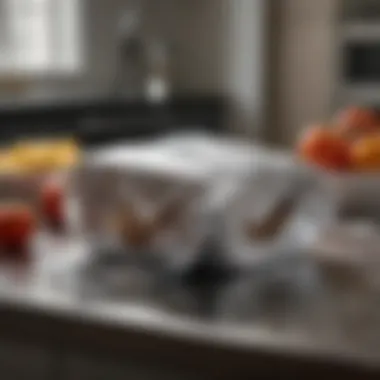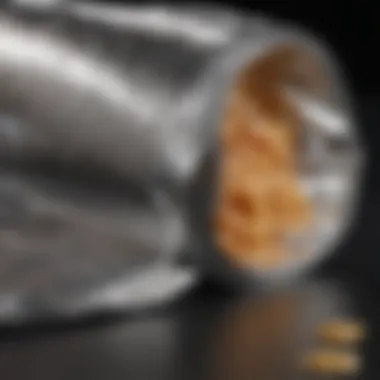The Versatility of Aluminum Foil Paper in Culinary Practices


Intro
Aluminum foil paper has been a kitchen staple for many years. It offers various applications that enhance cooking and food preservation. This section will detail the potential uses of aluminum foil paper to improve efficiency and effectiveness in the kitchen.
Recipe Overview
Creative Name: Roasted Vegetables in Foil
- Portions: 4
- Prep Time: 10 minutes
- Cook Time: 30-35 minutes
- Difficulty: Easy
Main Ingredients:
- Mixed vegetables (carrots, zucchini, bell peppers)
- Olive oil
- Salt and pepper
- Fresh herbs (rosemary or thyme), optional
Step-by-Step Instructions
- Prep Ingredients:
- Prepare Foil:
- Cooking the Dish:
- Wash and peel (if necessary) the vegetables. Cut them into uniform pieces to ensure even cooking. Aim for bite-sized chunks or slices for quicker cooking times.
- In a bowl, toss the vegetables with olive oil, salt, and pepper. Include fresh herbs if desired for added flavor.
- Lay out a large piece of aluminum foil. Make sure it is big enough to encase the vegetables completely.
- Place another layer of foil as a top cover, ensuring a tight seal to keep moisture in.
- Fold the edges of the foil to seal tightly, forming a packet. Place it on a baking tray.
- Bake in a preheated oven at 400°F (200°C) for 30-35 minutes. Check for doneness by carefully opening the foil packet to steam release and fork tenderness.
Time-Saving Strategies: Use leftover vegetables. You can substitute fresh herbs with dry alternatives based on availability.
Nutritional Information
Total Calories: Approximately 150 per serving
- Proteins: 3g
- Fats: 7g
- Carbohydrates: 18g
Beneficial Nutrients:
- Vitamins A and C from vegetables
- Healthy fats from olive oil
- Antioxidants from fresh herbs
Quick Cooking Tips
- Use Kitchen Gadgets: Consider using an air fryer or a slow cooker for similar recipes.
- Multitask Efficiently: While the vegetables are roasting, prepare a sauce or a salad.
- Healthier Alternatives: Instead of oil, you can use low-sodium vegetable juice for flavor without extra calories.
Related Recipes & Variations
- Complementary Dishes: Pair with grilled chicken or fish for added protein.
- Adaptations: Make this recipe vegan by omitting any animal-based products.
- Creative Twists: Marinate vegetables in different spices for unique flavors. Share your variations online.
Explore and experiment with aluminum foil paper to improve your culinary repertoire. Its ability to lock in moisture while cooking can elevate the flavor and texture of countless dishes.
Prologue to Aluminum Foil Paper
Aluminum foil paper has become a staple in kitchens worldwide. Its flexibility and usability extend far beyond that of typical cooking materials. A fundamental understanding of aluminum foil's properties enables individuals to deploy it efficiently in a variety of culinary situations. This section explores the layers of significance around this seemingly simple product.
Historical Overview
Aluminum foil has a rich history that began over a century ago. Its creation can be traced back to the early 20th century when it became commercially available. Originally, its applications were largely industrial, with uses in packaging and insulation. However, as the culinary world evolved, so too did the roles of materials used in food preparation and storage. By the 1920s, aluminum foil made its way into kitchens and has since established itself as a necessary tool for preparing meals.


The progression from a novel product to a kitchen mainstay reflects its unparalleled qualities, which include lightweight, non-reactive characteristics, and ability to withstand temperature variants without deforming. Historical narratives reveal how families adapted to the availability of aluminum foil, leaning towards its unique benefits.
What Aluminum Foil Paper Is
Aluminum foil paper is a thin sheet made from aluminum. It typically comes in rolls, making it easy to cut and manage. Its basic feature lies in its composition, which ensures durability against tearing while remaining lightweight. Well-known brands like Reynolds Wrap and IFoil have made significant contributions to the accessibility of aluminum foils.
Its main functions revolve around insulation, protection, and preparation processes. For instance, in the realm of cooking, aluminum foil uses include roasting and covering food. Its shiny side reflects heat and light, while the dull side absorbs them. This duality offers versatility unparalleled by other materials often found in kitchens.
Aluminum foil stands out for its non-absorbent nature, making it ideal for food storage. The barrier it forms against air and moisture helps preserve the quality of various culinary items, whether baked goods, meats, or wraps for leftovers.
In sum, these introductory insights into aluminum foil paper aptly set the stage for a more extensive reflection on its practical applications and benefits in the kitchen.
Properties of Aluminum Foil Paper
The importance of understanding the properties of aluminum foil paper cannot be understated when it comes to its practical applications in culinary practices. Exploring the specific elements such as its physical characteristics, thermal conductivity, and durability provides chefs with insights that can enhance efficiency in the kitchen. The unique attributes of aluminum foil paper make it a valuable asset for various cooking and food storage tasks. This section delves deeper into these properties, highlighting their significance in everyday kitchen use.
Physical Characteristics
Aluminum foil paper is known for its lightweight and flexible nature, making it exceptionally versatile for multiple cooking methods. Its thin yet resilient structure allows it to conform to different food items effectively, ensuring optimal coverage. The reflective surface is not just for aesthetics; it also plays a role in heat management, helping to maintain the desired temperature during cooking processes.
Moreover, its malleability means it can be shaped for various needs—whether it be for wrapping food, creating baking trays, or even making pouches for steaming. This adaptability allows chefs to think outside conventional cooking methods and devise creative solutions according to their culinary requirements. Understanding these physical characteristics empowers users to utilize aluminum foil paper in innovative ways, maximizing its usefulness.
Thermal Conductivity
Aluminum, in general, has high thermal conductivity, and foil paper is no exception. It distributes heat evenly, which is pivotal in cooking applications. This property ensures that food is cooked consistently, avoiding burnt edges or undercooked portions. For instance, when using aluminum foil to wrap a fish fillet or a vegetable medley, the heat transfer helps in achieving the desired texture and doneness while preserving moisture.
Furthermore, this aspect is crucial when employing techniques like grilling or baking. Instead of the intense direct heat affecting your food, aluminum foil allows for a buffer, regulating how heat interacts with the food surfaces. Knowing how to leverage the thermal conductivity of aluminum foil can lead to better cooking results, prompting cooks to be more intentional in how they leverage this commodity.
Durability and Ease of Use
Durability is another critical aspect of aluminum foil paper. It resists tears and punctures to a certain extent. This grocery staple is remarkably suited for everyday use, even in bustling kitchen environments. Chefs can rely on it to protect their food from exposure to oxygen and moisture, both of which can lead to spoilage. Moreover, the ease of use associated with aluminum foil paper stands out. It can be torn off effortlessly from the roll, and its application usually demands no special skills.
The convenience factor is significant in a busy kitchen. Cooks may quickly speed up food preparation by simply wrapping, covering, or even lining pans without the need for lengthy cleaning processes post-cooking. In an era where time is of the essence, the immediacy offered by aluminum foil enhances overall culinary productivity.
Ultimately, the properties of aluminum foil paper make it an often underappreciated but essential tool in the kitchen.
As culinary enthusiasts seek efficiency alongside performance, understanding its versatile aspects can enhance both the cooking journey and the final dish presentation. By acclimatizing themselves to these properties, individuals will need less time to prepare, cook, and store food, elevating the whole culinary experience.
Common Applications in Cooking
Common applications of aluminum foil paper in cooking are numerous and vital in facilitating various kitchen tasks. This versatile material allows for efficient food preparation, cooking, and storage. Recognizing these applications can empower culinary enthusiasts to enhance their efficiency. It provides a practical solution that aligns with contemporary cooking needs. Utilizing aluminum foil can lead to time savings, improved food preservation, and contributing to flavor maintenance.
Food Preservation
Aluminum foil paper plays a significant role in food preservation. Its ability to create an effective barrier against moisture and air effectively slows down spoilage. Wrapping food tightly in foil helps maintain freshness and flavors. Items like vegetables, meats, and leftovers benefit immensely from being stored in aluminum foil. The adaptability of the foil ensures it molds well around various food shapes, maximizing coverage. It maintains quality by reducing oxidation and controlling factors like humidity. Therefore, using aluminum foil can assist in retaining nutritional value while extending the lifespan of various foods.
Cooking Techniques
Grilling with Aluminum Foil Paper
Grilling with aluminum foil paper offers convenience and efficiency. By placing food in foil, individuals can achieve even cooking. It allows marinated vegetables or meats to retain moisture and flavor without risking burning or char. A key characteristic of this method is its ability to create a seal that traps heat and steam, producing tender results. The practicality of using foil also extends to the easy cleanup afterward, making it a favored technique in grilling. Though there may be some debate about smoke purity, many find the benefits outweigh the potential downsides in taste.
Baking in Foil
Baking in foil enables even heat distribution in the oven. By wrapping food, it can avoid drying out, especially for delicate items such as fish or cakes. One notable feature is that baking in foil helps to prevent sticking, minimizing the need for additional oils or non-stick sprays. As a result, this approach often leads to healthier meal preparations as well. Although some traditionalists may underestimate such methods, baking in foil has found its footing with busy home cooks looking for efficiency.


Steaming Food
Using aluminum foil for steaming food is another technique worth mentioning. This method enhances the mouthfeel and taste of food while preserving nutrients effectively. Wrapping food tightly allows the steam generated during the cooking process to circulate. This technique is particularly beneficial for vegetables, as it minimizes nutrient loss. One of the advantages of using aluminum foil is that it splendidly aids in creating portable packages for steaming, making meal prep simpler and more organized for the home chef. However, users should ensure that some openings are made to allow excess steam to escape and prevent unwanted sogginess.
Food Wrap and Storage Solutions
In addition to its cooking advantages, aluminum foil serves as an excellent food wrap and storage solution. It protects food from spoilage while keeping the flavors intact. Whether it’s wrapping sandwiches or storing leftovers, foil serves multiple functions. This makes it an essential item in any kitchen.
Using aluminum foil can improve storage organization and provide better access. Its flexibility and structure allow for customized wrappings suited to various food types. It helps streamline cooking practices and set practical storage options for busy enthusiasts.
Effective use of aluminum foil paper not only conserves meal quality but—when applied creatively—also promotes an organized kitchen workflow.
Household Uses Beyond the Kitchen
Aluminum foil paper is more than just a kitchen staple. Its utility extends into various household tasks. This versatility makes it a valuable tool, reducing waste and increasing efficiency in various chores. Understanding its applications outside the kitchen allows for a deeper appreciation of this simple material.
Cleaning and Maintenance
The cleaning power of aluminum foil paper is often overlooked. It serves as an excellent scrubbing tool for delicate surfaces. When crumpled into a ball, it can effectively remove rust from metals like chrome and stainless steel.
- Scrubbing Pots and Pans: A ball of aluminum foil can replace harsher scouring pads. It is especially effective against tough, burnt food residues without scratching the surface of your cookware.
- Shining Chrome Fixtures: For faucet fixtures, gently scrubbing with aluminum foil restores shine and removes water spots. This method adds not just cleanliness but also longevity to chrome surfaces.
Additionally, aluminum foil can be employed in protecting other surfaces during painting tasks or cleaning sessions. By covering furniture or other areas, you can avoid annoying messes that often accompany such activities.
Crafting and DIY Projects
Aluminum foil paper has found a niche in arts and crafts. Its malleability and reflective qualities appeal to crafters and DIY enthusiasts. This material can be used for various creative projects, ranging from simple decorations to complex art installations.
Some practical uses include:
- Creating Sculptures: Bending and shaping aluminum foil allows for impressive sculptural designs. Once formed, the foil can hold its shape well.
- Shiny Decorations: Foil can be cut into shapes and used as embellishments in gift-wrapping or card-making, adding a touch of elegance.
- Homemade Stencils: By cutting the foil into shapes, it can be used for painting designs on fabrics or walls. The effectiveness of its structure helps achieve sharp lines in the designs.
Important to note, the adaptability of aluminum foil encourages innovative approaches in households. Keep in mind, while using it in crafts, always ensure that you maintain clean and organized working areas to optimize the crafting process.
Aluminum foil paper is not just for cooking—it represents countless opportunities for creativity and efficiency in every household!
Advantages of Using Aluminum Foil Paper
Aluminum foil paper is more than just a kitchen staple. Its use brings numerous advantages that heighten kitchen efficiency and enhance cooking practices. When considering a busy cooking environment, certain practical elements of aluminum foil paper stand out. Its multifaceted applications can improve time management, cost efficiency, and address sustainability concerns. Examining these aspects helps culinary enthusiasts better understand why it should be a prominent fixture in their kitchen tools.
Time Efficiency in Cooking
Cooking often demands many tasks at once. In this context, aluminum foil paper provides time-saving attributes that cannot be overlooked. One major boon of using aluminum foil is its versatility in food preparation techniques. For instance, wrapping vegetables or meats with foil can reduce cooking time, as the heat circulates more efficiently.
Additionally, with grillable applications, meals can be cooked without lengthy clean-up. Simply tossing the foil engaged with remnants into the trash means your grill doesn’t need scrubbing after every use. Organizing meals into packets streamlines not just cooking, but cleanup.
Other approaches include:
- Preparation of multiple dishes concurrently on the stove or oven.
- Making use of aluminum foil to store leftovers more compactly, cutting down food reheating time.
With cooking made easier, more of one’s attention can be directed toward enjoying meals or engaging with family.
Cost-Effectiveness


When evaluating kitchen produce, price comparisons often guide decision-making. Aluminum foil provides effective costs that serve home cooking. Quantity options, whether on rolls or sheets, can cater to any budget. With varying thickness levels available, you can choose the relatively inexpensive variant suited for almost any task.
A key attribute is the capacity for reusability; many users clean off and use foil numerous times before disposal. This longevity helps elevate aluminum foil to a cherished position among economical cooking materials. Users often estimate their savings over time when relying on foil instead of specialty storage containers or discretionary products that may provide the same protection and convenience offered by foil paper.
Environmental Considerations
In today’s cooking landscape, overviewing environmental impact becomes vital. Assessing aluminum foil’s footprint highlights beneficial practices amid a bustling kitchen. While foil supports recycling, care should be given in proper disposal to ensure your efforts yield productive results. It is extreely crucial to engage in proper sorting considering foil derive from mined bauxite and this additionally bears long-term mineral implications both economically and environmentally.
Hence, those practicing home cooking can ascertain that choosing aluminum foil does signify navigations towards sustainable means. Making conscious decisions about its use, reusing when feasible, and MPicture sections enable effective upward trends hinting at resolve towards both economic and impactful responsibilities. For more on sustainability in culinary practices, consider visiting resources like Britannica or community discussions on platforms like Reddit for insights.'
Limitations and Considerations
When exploring the practical applications of aluminum foil paper, it is critical to address its limitations. Understanding these elements helps culinary enthusiasts make informed decisions and reduces potential pitfalls in the kitchen. While aluminum foil is versatile, its use must be balanced with awareness of specific health concerns and sustainability issues tied to its production and disposal.
Health Concerns
Aluminum foil is widely recognized for its efficiency in cooking, but certain health concerns warrant consideration. Studies suggest that cooking acidic foods, such as tomatoes or citrus, with aluminum foil may cause a leaching of aluminum into the food. This can be further exacerbated by high-temperature cooking, which may increase the transfer rate of aluminum into the meal.
Though the body usually excretes consumed aluminum safely, excessive accumulation may pose health risks over time. This concern is particularly relevant for vulnerable populations, such as individuals with kidney disease, who may not eliminate aluminum effectively. Therefore, it is advisable for cooks to avoid extensive use of aluminum foil for wrapping acidic foods or using cooking techniques involving high temperatures. Instead, opt for alternatives like parchment paper or glass containers in these scenarios.
Sustainability Issues
The production and disposal of aluminum foil raise significant sustainability issues. While aluminum is a recyclable material, a small percentage is actually repurposed in practice. The extraction and processing of bauxite ore, the primary source for aluminum, is energy-intensive and contributes to environmental degradation, from deforestation to greenhouse gas emissions.
Choosing aluminum foil can, therefore, lead to an increased carbon footprint, making it crucial for users to consider this impact on the environment. Moreover, aluminum foil does not biodegrade naturally, adding to landfill waste. As culinary enthusiasts, encouraging the recycling of aluminum foil is essential, however there remains a pressing need to explore more incremental or renewable alternatives for cooking and food storage.
In summary, while aluminum foil paper serves multifarious functions in the kitchen, a thorough understanding of its limitations is paramount. The health concerns and sustainability issues mentioned above should not only inform usage practices but also guide us towards more conscious culinary habits. Ultimately, balancing the benefits of aluminum foil with these considerations can enhance our cooking meanwhile safeguarding health and environmental values.
"Awareness of aluminum foil's limitations ultimately shapes a responsible approach to cooking and food preservation."
Expert Tips for Utilizing Aluminum Foil Paper
Aluminum foil paper is a remarkably useful tool in any kitchen. As culinary enthusiasts seek to enhance their efficiency and simplify their processes, understanding how to correctly and effectively use aluminum foil becomes essential. This section provides expert tips that go beyond mere suggestions, drawing attention to specific techniques that enhance preparation, cooking, and preservation. The insights offered here cater to a diverse range of cooking styles, ensuring there is value for everyone.
Optimal Usage Techniques
Several approaches maximize the potential of aluminum foil paper. Proper usage can transform the mundane acts of cooking and storing food into moment-efficient rituals.
- Avoiding Direct Contact with Acidic Foods: When using aluminum foil for acidic substances, such as tomatoes or citrus, ensure to use parchment paper or a plastic wrap layer as a barrier. This prevents any reaction that may impart flavors or health risks.
- Creating Custom Pans: When traditional cookware is unavailable, aluminum foil can serve contingent needs. Use it to create makeshift baking trays or dishes. Proper folding techniques enhance durability while shaping, allowing high temperatures without unexpected burning.
- Cooking with Precision: When molding foil into packets for grilling, strategic fold beams can promote even cooking. Be precise with measurements and trusted heat sources to manage optimal result ranging from baked items to roasted vegetables.
- Layering for Extra Protection: When using aluminum foil for baking or broiling, use double layers for additional insulation. It retains heat and ensures the food remains moist, which is vital for producing well-cooked meals.
- Preparing Fast, Flavorful Steam Dishes: Fold a piece of aluminum foil into a shallow pocket, place it atop boiling water, and steam vegetables or fish conveniently. This technique locks in steam and flavor without excessive cleaning afterwards.
Storage Guidelines
Aluminum foil also plays a decisive role in food storage. Keeping edibles fresh and safe requires understanding of its properties and best practices.
- Wrapping Leftovers Efficiently: To maintain freshness when wrapping leftovers, ensure that any exposed areas of food do not make direct contact with stale air. Close the foil tightly around the items.
- Labeling for Clarity: If freezing portions, label each packet indicating content and date. Even seasoned cooks can forget what a wrap contains when rummaging through freezers.
- Avoid using Foil as Replacement for Proper Storage: While aluminum is useful for temporary preservation, it is essential to employ designated containers.
- Conserving space with Proper Folding: When neatly folding leftover foil, minimize mess and utilize only needed length to fill gaps in refrigerator storage. Neater storage allows for an organized space.
- Ditching Single-Use Patterns: Practice sustainable usage of aluminum foil by frequent recycling and exploring alternative use cases. This not only economizes resources but also supports environmental responsibility.
Utilizing aluminum foil isn't merely a practicality; it's an art centered on productivity, quality, and responsibility.
By understanding optimal techniques and storage guidelines, culinary enthusiasts can leverage the value of aluminum foil paper for superior food management in their kitchen endeavors.
Epilogue
The role of aluminum foil paper in the kitchen cannot be understated. This article illuminates various practical applications of this seemingly simple material. From its unique properties to its numerous uses, aluminum foil paper is a crucial component in the culinary world.
Recap of Benefits
- Versatility: Aluminum foil paper adapts to multiple cooking methods and preservation needs. It excels in grilling, baking, and steaming, enhancing flavor while retaining moisture.
- Efficiency: The time-saving aspect of aluminum foil is significant. It enables quicker meal preparation and clean-up. You can wrap, cover, or directly cook with it.
- Cost-effectiveness: Generally affordable, aluminum foil provides value for money, offering many benefits per roll. For busy individuals, it is a worthwhile investment.
- Preservation: Aluminum foil prevents spoilage by creating airtight seals. This function helps maintain the freshness and tastes of various foods.
- Flexible in Use: With its malleability, aluminum foil can be shaped into different forms to suit specific cooking techniques or storage requirements.
Final Thoughts on Practical Use
In summary, aluminum foil paper's versatility extends beyond culinary applications. When exploring intelligent resource management in the kitchen, it is essential to recognize both the unique benefits and the considerations that come with it. Awareness of its limitations can guide a more informed practical application in everyday cooking. As culinary enthusiasts, narrowing the scope of efficiency is critical. Utilizing aluminum foil not only upgrades cooking methods but also enriches meal experience overall. Embracing these insights and practical tips can lead to more streamlined cuisine processes. This ultimately helps in making an informed choice on the daily, enhancing kitchen efficacy, safety, and enjoyment. By integrating this simple material judiciously, one can greatly elevate the home cooking standard while optimizing kitchen workflow.







